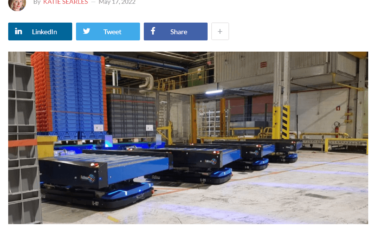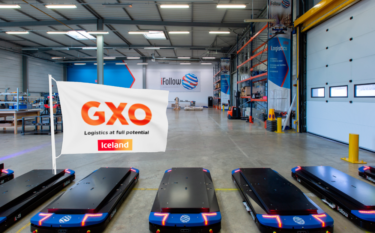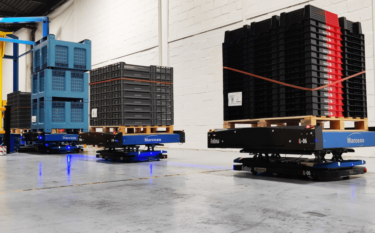Les pics d’activité dans le secteur de la vente au détail peuvent constituer un véritable défi pour les opérations intralogistiques.
Les robots mobiles autonomes (AMR) offrent une solution rentable qui contribuera à éliminer une grande partie des risques, à atténuer les pointes et à garantir la continuité du service aux clients.
de supprimer une grande partie des risques, d’atténuer les pics et d’assurer la continuité du service aux clients.
Il n’y a pas si longtemps, un pic dans le commerce de détail était synonyme de Noël. Aujourd’hui, il y a toute une saison de pics
à l’automne, en commençant par le vendredi noir, Noël, puis le lendemain de Noël.
Cette année, la Coupe du monde de football est venue s’y ajouter, ce qui montre que les pics peuvent survenir à tout moment.
peuvent survenir à tout moment.
La crise du coût de la vie devrait avoir un effet modérateur sur la saison de pointe de cette année.
Cette année, la haute saison devrait être freinée par la crise du coût de la vie, même si le « vendredi noir » pourrait être une exception, car les acheteurs étalent le coût de Noël en profitant des avantages offerts par les magasins.
de Noël en profitant de prix réduits. Le cabinet de conseil PwC estime que les
les dépenses globales liées aux bonnes affaires du vendredi noir s’élèvent à 7,5 milliards de livres sterling cette année, soit 0,5 milliard de livres sterling de plus que l’année dernière.
l’année dernière. Néanmoins, on s’attend à ce que les consommateurs réduisent leurs dépenses dans les mois à venir, sous une forme ou une autre, en particulier dans les secteurs autres que l’automobile.
dans les mois à venir, en particulier dans le domaine des produits non alimentaires. Cela accroît la pression sur les détaillants
pendant la période la plus importante de l’année, alors qu’ils doivent faire face à des factures d’énergie et de main-d’œuvre plus élevées et à une augmentation des coûts des produits de base.
With profit margins under intense pressure and given the crucial role warehouse operations
play in ensuring that customers are not let down, retailers are looking for flexible and cost-effective
intralogistics solutions that can help to improve their bottom line and achieve their
priorities – including continuity of customer service levels. Resources such as warehouse
shelf space and labor are tight. To cope with peaks, it may be necessary to change modes
de fonctionnement, ce qui peut se traduire par des routines de prélèvement différentes dans l’entrepôt, par exemple.
Traduit avec www.DeepL.com/Translator (version gratuite)
To support this need for flexible intralogistics processes, it makes sense to have
easily adaptable, robust and reliable equipment that not only performs everyday functions
but can also be scaled up whenever necessary to meet peak demand.
Few items of intralogistics equipment tick these boxes as successfully as AMRs, which is one of the
reasons why robotics has become an integral part of warehouse operations.
According to the International Federation of Robotics report, half a million industrial robots were installed
in 2021 globally. This represents a growth rate of 31% year-on-year and exceeds the pre-
pandemic record of robot installation in 2018 by 22% – we can call that a new peak.
A significant advantage of using mobile robots in retail warehouses is that, unlike systems that are
fixed to the ground, such as conveyors and automated storage and retrieval systems, is the
ability to add and remove robots to meet demand.
Given that they do not require infrastructure support, their tasks can be easily modified to suit changes in requirements.
They offer simple automation that can enhance productivity. For example, assigning one
zone per operator and organizing the robot’s shifts according to the products it has to pick
will maximize the number of picks per hour achieved by a picker and will minimize their
movements. This allows the operator to gain up to 90% in productivity compared to manual
preparation.
Duo-picking is an excellent way of working efficiently with one or more mobile robots. Each
the operator is equipped with a voice terminal, a Radio Frequency (RF) terminal, or an order-picking tablet to read the list of items to be picked.
This picking method allows the operator to gain up to 50% in productivity compared to manual picking.
Fleet management software that can manage up to 200 robots and works with all ERP and
WMS systems will efficiently allow locations and tasks to be modified with just a few clicks.
Christmas being the busiest time for grocery retail is a trend that is unlikely ever to change,
despite current economic conditions. The ability to handle two roll cages up to 1500 kg on
one robot, which is a stand-out feature on our AMRs, will be a massive help to
warehouse operators looking to keep the supermarket shelves full of everything required
for Christmas.
Our AMRs can also operate in cold rooms down to -25°C and ensure the
absence of condensation, even when moving from a very cold environment to a temperate
space, demonstrating their flexibility and reliability.
Predicting and managing future events in a volatile retail economy will always be
difficult. Mobile robots offer an excellent intralogistics solution to support agile retailers that
cannot afford to disappoint at peak. But remember: robots aren’t just for Christmas – they
should be at the core of everyday intralogistics operations, continually providing flexibility
and improving productivity.


